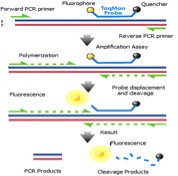The principle of the real-time detection is based on the fluorogenic 5’nuclease assay. During the PCR reaction, the DNA polymerase cleaves the probe at the 5’ end and separates the reporter dye from the quencher dye only when the probe hybridizes to the target DNA. This cleavage results in the fluorescent signal generated by the cleaved reporter dye, which is monitored real-time by the PCR detection system. The PCR cycle at which an increase in the fluorescence signal is detected initially (Ct) is proportional to the amount of the specific PCR product. Monitoring the fluorescence intensities during Real Time allows the detection of the accumulating product without having to re-open the reaction tube after amplification.

Dengue fever and dengue hemorrhagic fever (DHF) are viral diseases transmitted by Aedes mosquitoes, usually Aedes aegypti. It is caused by one of four closely related virus serotypes of the genus Flavivirus, family Flaviviridae, each serotype is sufficiently different that there is no cross-protection and epidemics caused by multiple serotypes (hyperendemicity) can occur. It is found in most tropical and subtropical areas of the world, and has become the most common arboviral disease of humans. More than 2.5 billion persons now live in areas where dengue infections can be locally acquired. Epidemics caused by all four virus serotypes have become progressively more frequent and larger in the past 25 years. As of 2005, dengue fever is endemic in most tropical countries of the South Pacific, Asia, the Caribbean, the Americas, and Africa. In 20-30% of DHF cases, the patient develops shock, known as the dengue shock syndrome (DSS). Worldwide children younger than 15 years comprise 90% of DHF subjects.
